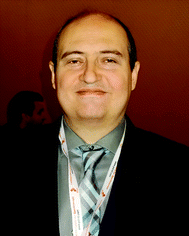The JAAS community: we few, we lucky few, we band of brothers
I was going to entitle this Editorial either “Cite me to the end of love” or “Everybody knows the dice are loaded”, in memory of Leonard Cohen, who sadly passed away as I was working on it. As you can guess, my original focus was going to be on metrics and citations. However, I realized while writing it, that there are aspects much more important for us, all people related to JAAS, than those numbers. Thus, I will not discuss them (too much). Of course we are happy to see that, after 31 years of life, JAAS is a mature journal, with an evolving but clear scope1 and it is still firmly positioned in the Q1 section of both Analytical Chemistry and Spectroscopy categories in the Thomson Reuters Journal Citation Reports®, despite the constant evolution of the field, and the appearance of many competing journals. It is interesting to notice that the first journals in the spectroscopy area are all review journals, who have obvious advantages in terms of impact factor, while the top journals in the analytical chemistry category tend to be occupied by journals with a broader scope that publish many articles per year.JAAS follows a different approach. We are compelled to publish the best original research, as well as meaningful review articles, produced by the community of atomic spectroscopists and related scientists. We believe that a journal with such scope, publishing over 200 articles per year, still is the right tune for many of us.2 In a changing world, where personal metrics (h-index, n-index) are becoming even more relevant than journal metrics for every particular author, it is important to publish your research in a venue that reaches the right audience, who will value it properly. Otherwise, it is not uncommon to see good articles from our area getting published in broader journals, where they may not receive all the attention/citations that they probably deserve.
Our goal is to further strengthen the allegiance of JAAS with our community, and we have taken a number of initiatives in that regard over the last few years, which perhaps are worth mentioning. In the first place, I would like to stress our sincere commitment to the younger scientists, who will cement the future of our field. JAAS is publishing in the summer of 2017 the 5th themed issue devoted to Young Analytical Scientists, guest edited by Dr Jorge Pisonero, from the University of Oviedo. It seems only yesterday when I was so proud to be selected for the first of such issues in 2002! Young authors who contribute to this issue must be corresponding authors of their manuscripts. The 4th issue was published in 2014.3
Moreover, in 2015 and coinciding with the 30th anniversary of the journal, the JAAS Emerging Investigator Lectureship was launched. This lectureship is awarded annually to recognize and support an emerging scientist working in the area of atomic spectrometry in the early stages of their independent career. The recipients of the lectureship will receive support to present their research at a relevant high-profile international meeting, together with a certificate and an invitation to contribute a Perspective or full paper article to JAAS. The inaugural Lectureship was last shared between Dr Lara Lobo Revilla, from the University of Oviedo, and Dr Gerardo Gamez, from Texas Tech University.4 In 2016, the recipient will be Dr Sohail Mushtaq, from London Metropolitan University.5 He will receive his award in June 2017 in Pisa, during the Colloquium Spectroscopicum Internationale XL.6
In addition to the issue devoted to young authors, we will like to honor the memory of the former Chair of JAAS and Metallomics, our friend and mentor, the late Dr Joseph A. Caruso, with a joint online themed collection between both journals that will be guest edited by Gary Hieftje, from Indiana University and María Montes-Bayón, from the University of Oviedo. We will use the web collection format, which enables us to have more flexibility regarding submission deadlines, and also permits the collection to grow over time.
We are also thinking of new ways to thank our referees for their indispensable help. Only thanks to their commitment is it feasible to keep the journal running, with an average time of 35 days, from the receipt of a manuscript to the first decision. We want to express our sincere gratitude to all of them and particularly acknowledge the most prolific ones, who have been recently listed in the JAAS blog.7
We are also always eager to meet authors, referees and scientists in general. We'll do our very best to ensure that members of the JAAS Editorial Office and/or the Editorial Board are present at every major conference where atomic spectrometry is represented. In 2017, you can easily find some of us at the European Winter Conference on Plasma Spectrochemistry (a web themed collection devoted to this conference will be published in the summer), Pittcon, the 14th Rio Symposium on Atomic Spectrometry, the above mentioned Colloquium Spectroscopicum Internationale XL or the SciX conference, to name some of the symposia we will be attending.
We hope to meet you at one of these conferences, or hear from you via Twitter8 or the JAAS blog.9
Let's keep in touch!
Martín Resano
References
- F. Vanhaecke, J. Anal. At. Spectrom., 2015, 30, 1015–1016 RSC.
- B. Sharp, J. Anal. At. Spectrom., 2006, 21, 1365–1366 RSC.
- http://rsc.66557.net/en/journals/articlecollectionlanding?sercode=ja&themeid=fddd7f5e-0e19-44fd-bb33-8fbc16f55392, last accessed in November 2016.
- http://blogs.rsc.org/ja/2015/05/14/jaas-emerging-investigator-lectureship-awardees, last accessed in November 2016.
- http://blogs.rsc.org/ja/2016/10/13/jaas-emerging-investigator-lectureship-recipient/, last accessed in November 2016.
- http://www.csi-conference.org, last accessed in November 2016.
- http://blogs.rsc.org/ja/2016/09/22/top-10-reviewers-for-jaas/, last accessed in November 2016.
- https://twitter.com/jaasnews, last accessed in November 2016.
- http://blogs.rsc.org/ja/, last accessed in November 2016.
| This journal is © The Royal Society of Chemistry 2017 |

